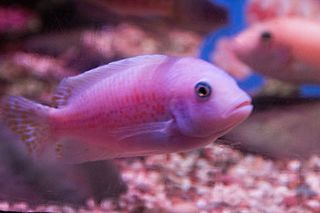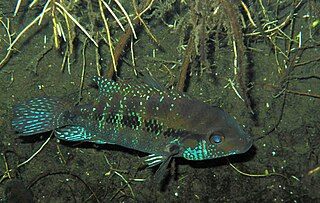
Cichlids are fish from the family Cichlidae in the order Cichliformes. Traditionally Cichlids were classed in a suborder, the Labroidei, along with the wrasses (Labridae), in the order Perciformes, but molecular studies have contradicted this grouping. On the basis of fossil evidence, it first appeared in Argentina during the Early Eocene epoch, about 48.6 million years ago; however, molecular clock estimates have placed the family's origin as far back as 67 million years ago, during the late Cretaceous period. The closest living relative of cichlids is probably the convict blenny, and both families are classified in the 5th edition of Fishes of the World as the two families in the Cichliformes, part of the subseries Ovalentaria. This family is large, diverse, and widely dispersed. At least 1,650 species have been scientifically described, making it one of the largest vertebrate families. New species are discovered annually, and many species remain undescribed. The actual number of species is therefore unknown, with estimates varying between 2,000 and 3,000.

Cichlasoma is a genus of freshwater fish in the cichlid family. The genus was previously very large, including cichlids from North America, including Central America, and South America.

Mayaheros urophthalmus, also known as the Mayan cichlid or Mexican mojarra is a species of cichlid.

Thorichthys is a genus of cichlid fish that is native to the Atlantic slope of Middle America, ranging from southern Veracruz and the Yucatán Peninsula in Mexico, to Guatemala and Honduras, with introduced populations in a few other countries. They tend to inhabit moderately-flowing to standing water such as rivers, streams, lakes, ditches and lagoons, and they are primarily freshwater fish, although T. helleri and T. meeki may occur in slightly brackish habitats.

Vieja is a genus of cichlid fish from Central America and Mexico. The majority of the species are freshwater fish found in stagnant or slow-moving waters of southern Mexico to El Salvador, but V. maculicauda, which also occurs in brackish waters, ranges south to Panama. They are high-bodied cichlids that reach lengths of up to 17–35 cm (7–14 in) depending on the exact species. Vieja feed mostly on vegetable matter, but may also take small invertebrates.

The poor man's tropheus is a species of fish in the family Cichlidae. Until 2007 it was the only species in the genus Neetroplus, but at that time it was reclassified into the genus Hypsophrys. In 2016 it was restored to the genus Neetroplus based on genetic research by Říčan, et al.

Archocentrus is a genus of cichlid fish from Central America. It currently contains a single species, the flier cichlid, which is found in stagnant and slow-moving freshwater habitats such as lakes, ponds, ditches, swamps and rivers in Honduras, Nicaragua and Costa Rica. It is up to 11 cm (4.3 in) long and feeds on invertebrates and detritus.

Amphilophus is a genus of cichlid fishes from Central America, ranging from southern Mexico to Panama. The genus currently contains 23 species, including several that are well known from the aquarium trade. However, studies led by Oldřich Říčan in 2008 and 2016 suggested that several species within Amphilophus should be moved to the genus Astatheros. Species proposed to be moved to Astatheros in 2008 were A. alfari, A. altifrons, A. bussingi, A. diquis, A. longimanus, A. macracanthus, A. margaritifer, A. rhytisma, A. robertsoni and A. rostratus. Further genetic studies led Říčan to put A. macracanthus in Astatheros, but to put A. alfari, A. altifrons, A. bussingi, A. diquis, A. longimanus, A. rhytisma, A. robertsoni and A. rostratus within the genus Cribroheros. Říčan's study suggests that the Astatheros species are more closely related to the Jack Dempsey and rainbow cichlid than to the remaining Amphilophus species.

Herichthys is a genus of cichlid fishes native to North and Central America. Most are endemic to Mexico, but H. cyanoguttatus is also found in southern Texas, and has been introduced to central Texas and Florida.

Herotilapia multispinosa also known as the rainbow cichlid is a Central American freshwater fish of the cichlid family. It is found on the Atlantic slope of Honduras, Nicaragua, and Costa Rica from Patuca River (Honduras) south to Matina River, and on the Pacific slope of Nicaragua and Costa Rica from Guasaule River south to Tempisque River. Specimens are also reported from the Choluteca River on the Pacific side of Honduras. This species is found in lakes and swamps with muddy bottoms, where it uses its specialized teeth and only 3.5% jaw protrusion to feed mostly on algae. It is commercially important as an aquarium fish. The rainbow cichlid prefers a pH range of 7.0–8.0, water hardness of 9-20 dGH and a temperature range of 21–36 °C.

Heroini is a fish tribe from the Cichlasomatinae subfamily in the family Cichlidae (cichlids). All cichlids native to the Greater Antilles, United States, Mexico and northern Central America are members of this tribe. It also includes most cichlid species in southern Central America and several species from South America. A large percentage of its species were formerly placed in the genus Cichlasoma but have since been moved to other genera.

Cribroheros robertsoni, also known as the false firemouth cichlid, is a species of cichlid found in Central America in the Atlantic slope from Mexico to Honduras in the Coatzacoalcos River.
The Cichlid Room Companion (CRC) is a membership-based webpage dedicated to the fishes of the Cichlid family (Cichlidae). The site was launched in May 1996 and offers arguably the most comprehensive authoritative catalogue of cichlids on the web, which is illustrated with more than 25,000 photographs of fishes and 2,000 of habitats, as well as over 300 videos of cichlids and their habitats. It also “offers access to ample information about 253 genera and 2371 species”, a discussion forum as well as many articles about taxonomy, natural history, fish-keeping, field accounts, conservation, and other cichlid related topics; mostly written by citizen scientists and people who specialize in cichlids. The species summaries provided in the form of profiles include taxonomic, distribution and habitat, distribution maps, conservation, natural history, captive maintenance, images, videos, collection records, and an extensive bibliography of the species included and have been prepared by world-class specialists. A document establishes the standards followed in the preparation and maintenance of the cichlid catalogue. The site is administered by its creator and editor, Juan Miguel Artigas-Azas, a naturalist, who is also an aquarist and a nature photographer. In 2008, the American Cichlid Association (ACA) awarded Artigas-Azas the Guy Jordan Retrospective Award, which is the maximum honor that association gives to people who have done extensive contribution to the international cichlid hobby.

Maskaheros is a genus of cichlids fish found on Atlantic slope of southern Mexico and Guatemala in the Coatzacoalcos and Usumacinta River drainages. They are relatively large, high-bodied cichlids and were formerly included in the genus Paraneetroplus or Vieja.
Kihnichthys ufermanni, the Usumacinta cichlid, is a species of cichlid found in a few rivers in the Usumacinta River basin in Guatemala and southern Mexico. It typically occurs in rivers that are about 10–50 m (33–164 ft) wide, fairly deep, have few or no aquatic plants, and a variable water current. This species is the only known member of its genus, but several of its features, including the chisel-like teeth, are shared with Cincelichthys and whether they should be merged into a single genus is not yet fully resolved; a review in 2020 recommended that the Usumacinta cichlid should be moved into Cincelichthys. The Usumacinta cichlid reaches a standard length of 25 cm (10 in).

Cincelichthys is a genus of high-bodied cichlids found in southern Mexico to Guatemala, where they inhabit lakes, rivers and other freshwater habitats. They are large cichlids, up to 35–42.5 cm (14–17 in) long depending on species, with females reaching smaller sizes than males.
The Montecristo cichlid is a species of freshwater fish from the Atlantic slope of southern Mexico and Guatemala. This cichlid occurs in lagoons, creeks and rivers with slight to moderate current in the Grijalva–Usumacinta, Candelaria, Champotón and Coatzacoalcos river drainages. It is currently recognized as the only species in its genus, but it is closely related to –and possibly should be merged into– Vieja. The Montecristo cichlid reaches up to 24 cm (9.4 in) in standard length.
The bluemouth cichlid is a species of cichlid fish that is endemic to the Usumacinta River basin in southern Mexico and Guatemala, where it is widely distributed in rivers, creeks and lakes. This species is the only known member of its genus. The specific name honours the French cichlid specialist Jean Claude Nourissat (1942-2003), who collected type of this species. It reaches up to 22 cm (8.7 in) in total length.
Isthmoheros tuyrensis, is a species of cichlid fish found in slow-moving freshwater habitats on the Pacific slope of eastern Panama. Before it was recognized as the only member of the genus Isthmoheros, it was placed in several other genera, including Cichlasoma, Vieja and others, but it is not particularly closely related to any of these. The nearest relative of I. tuyrensis is Talamancaheros. I. tuyrensis reaches up to 23.5 cm (9.3 in) in standard length and eats vegetable matter and detritus.

Mayaheros is a genus of cichlid fish that is native to Mexico and northern Central America. This genus has a disjunct distribution, with the M. urophthalmus group being found in the Atlantic drainages of southeastern Mexico, Belize, eastern Guatemala, northern Honduras and northeastern Nicaragua, while M. beani is the northernmost cichlid in the Pacific drainage, ranging from Jalisco to Sonora in northwestern Mexico. Both inhabit a wide range of habitats such as freshwater rivers, streams, lakes, ponds, pools and marshes, as well as brackish waters like estuaries, lagoons and mangrove, with members of the M. urophthalmus group sometimes even occurring in caves or coastal marine waters. They are medium-sized to large cichlids that are omnivorous, feeding mostly on small animals, but also plants and detritus.
















